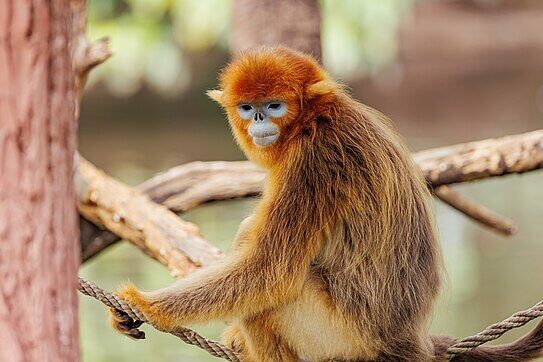
Until the 1980s, people in central China’s Shennongjia mountains hunted monkeys for meat and fur, while poor farmers cleared vast areas of forest. As the environment collapsed, so too did the golden snub-nosed monkey population, falling to fewer than 500 in the wild.
That was the situation when Yang Jingyuan, fresh out of university, arrived in 1991.
“The monkeys’ home was being destroyed by logging so their numbers were going down fast,” he says. “Now it’s being protected, and the monkey figures are really improving.”
Today, at 55, Professor Yang is director of the Shennongjia National Park Scientific Research Institute, and few people know this rare species better. He has devoted his entire career to studying and protecting the monkeys, which live only in these Hubei mountains.
In the forest, he watched as the monkeys descended from the trees. They tugged at his hands, touched him curiously, and appeared to study us as much as he did them. Yang even mimicked their calls, explaining that he now understands many of their vocalisations.
“Yes,” he said. “Yeeee is telling others the area is safe. They can come over. Wu-ka means it’s dangerous. Be careful.”
The species lives in highly complex social groups. A single male leads a family of three to five females and their young, with families merging into larger bands of more than 100 individuals. Bachelor males gather in their own groups, sometimes acting as guards. Females mate secretly outside their families, sparking tension, while violent clashes erupt both within families and between rival bands over territory.
At six years old, females leave to join other groups, preventing inbreeding. Monkeys live to around 24, and near the end of their lives, they slip away alone to die in hidden places—so well concealed that rangers say they have never found a body.
This thriving forest of 400 square kilometres (155 square miles) is a far cry from the bare hills of the past. Although the park was officially established in 1982, local ranger Fang Jixi, 49, recalls how it took years for impoverished farmers to stop destroying the habitat.
“People were very poor in these mountains and hunger was a real concern. There was no concept of protecting wild animals,” he said.
“Even after logging was banned there were still people illegally felling timber. If they didn’t cut down trees, how would they have money? There were also people secretly hunting here to survive. It was only after a long period of building awareness that the consciousness of local farmers changed.”
Gradually, the farmers became protectors instead.
“When the change occurred it was the scientists who told us you can actually come and work with us. You can have a job here to help the animals,” Mr Fang said.
Today, Fang patrols the hills for poachers and helps researchers track the monkeys’ movements, though the animals can cover in minutes what takes a human an hour to walk.
The turnaround was not easy. A major push came in 2005, when Prof Yang and colleagues formed a specialist study team. To earn the trust of one particular group, they spent an entire year drawing closer—closing the gap from 800 metres to direct contact.
“They were very afraid of us at first. When they saw us from far away they all fled,” said Prof Yang.
“I was so excited because finally they had become my friends. Every day we could be together and communicating,” he said.
Old photos show treeless slopes with only 60% coverage; now, with reforestation reaching about 96%, drone footage confirms a transformed landscape.
Tourism has followed. Millions have visited in recent years, though strict monkey protection zones remain off limits except to researchers. On a mountain path in one such zone, we passed monitoring equipment used to study monkeys, black bears, boar, and other wildlife. From a high vantage point, we looked over a valley once occupied by farmers, now relocated with government support. One man told us he was glad to have left the hardship of remote mountain life, and now ran a guesthouse with his family.
Despite progress, challenges remain. Golden snub-nosed monkeys reproduce slowly, with females bearing only one infant every two years—and not all survive. Yet numbers have climbed from under 500 to more than 1,600, and conservationists hope the population will exceed 2,000 within the next decade.
“I’m very optimistic,” said Prof Yang. “Their home is now very well protected. They have food and drink, no worries about life’s necessities and, most of all, their numbers are growing.”
——————————————————————————
At Natural World Fund, we are passionate about restoring habitats in the UK to halt the decline in our wildlife.

